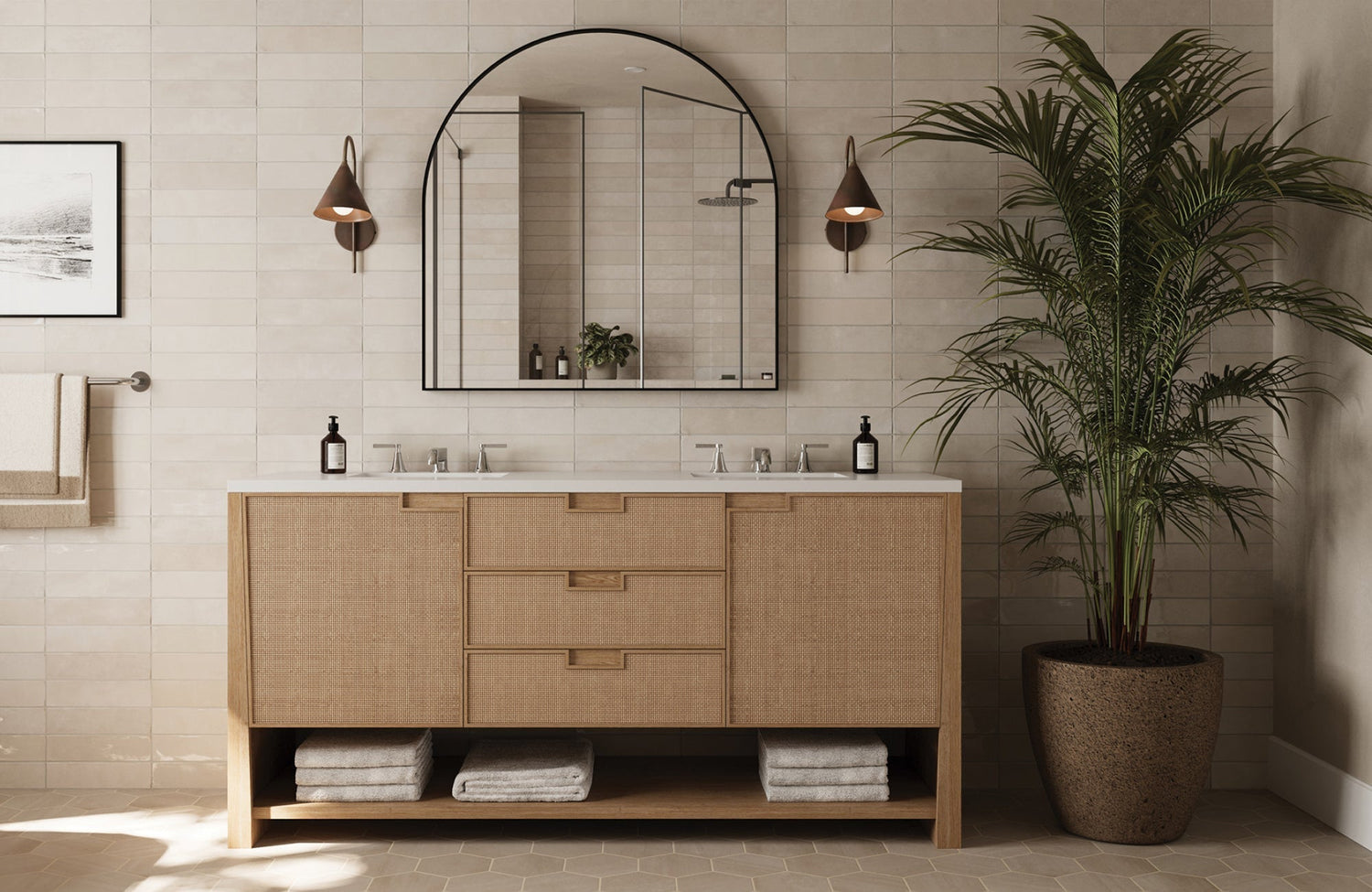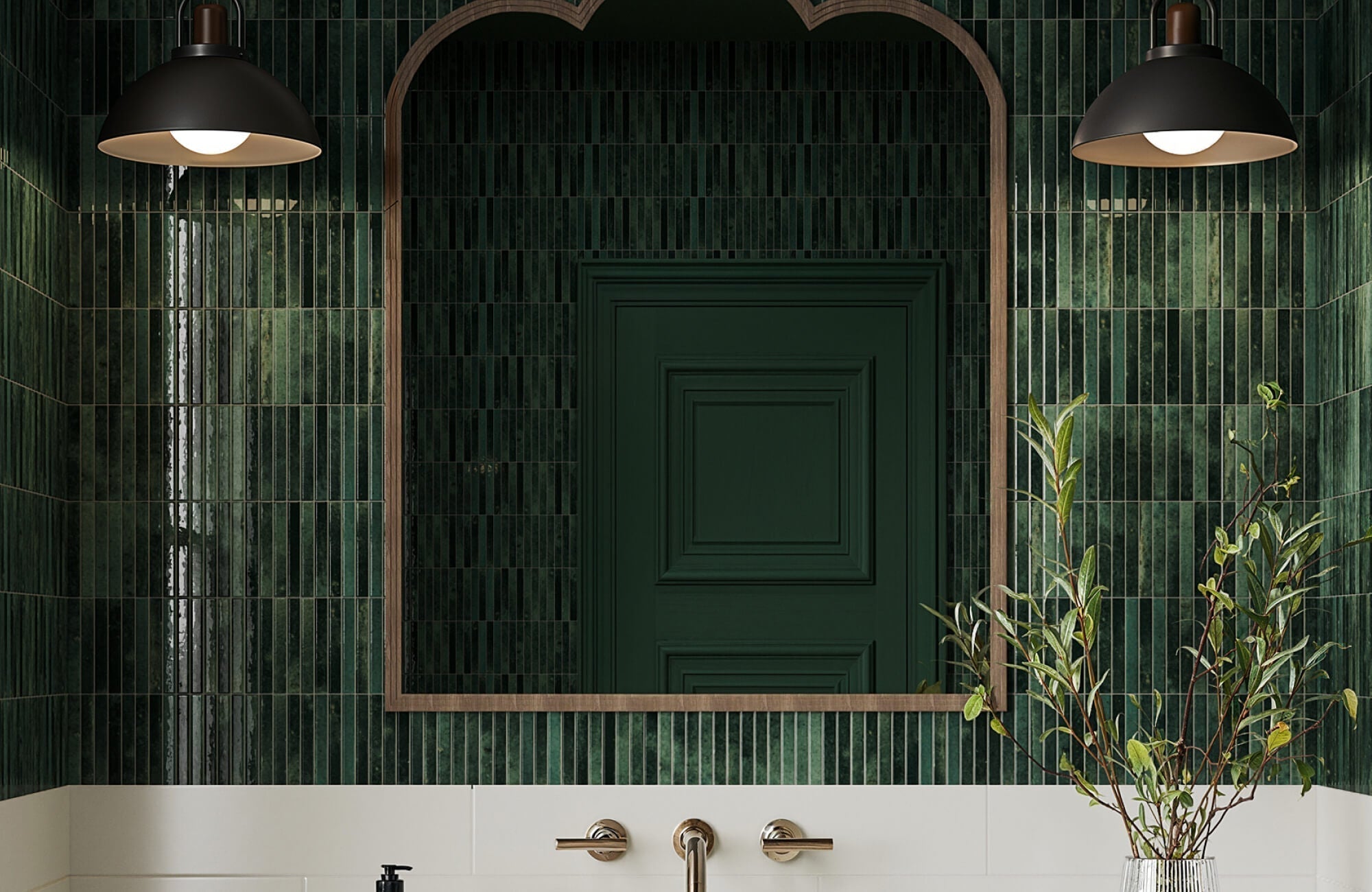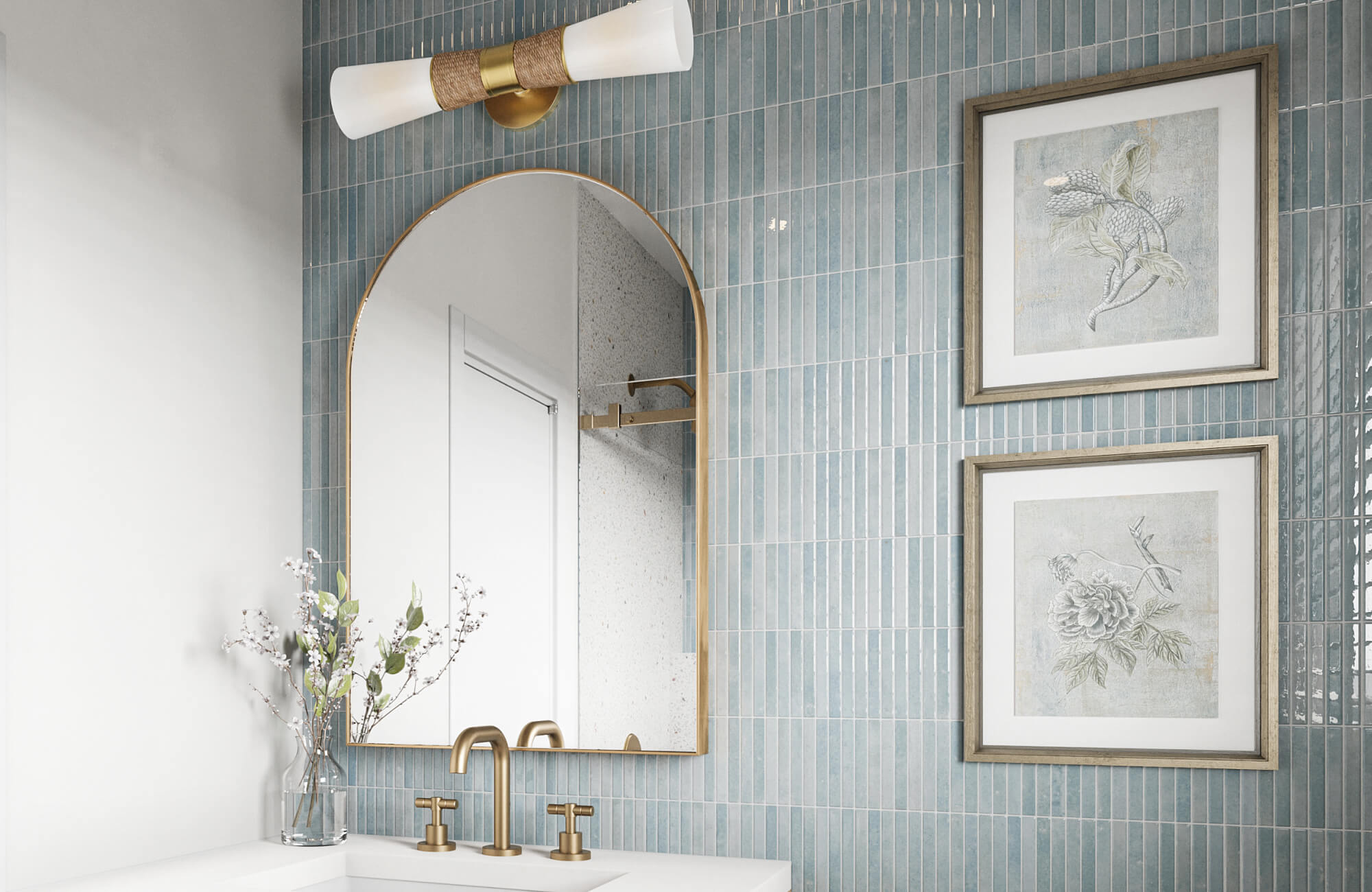Choosing the right bathroom mirror may seem straightforward, but it can significantly impact the overall ambiance of your space. From functionality to aesthetics, mirrors play a bigger role than most of us realize. If you’re upgrading or renovating, the right mirror won’t just reflect your face; it’ll reflect your style, enhance the bathroom’s layout, and improve your daily routine. Let’s walk through exactly what to look for to make a smart, informed choice.

Consider the Size and Scale of Your Space
Choosing the right mirror begins with getting the proportions just right. It should feel naturally integrated into the room, enhancing the space without overwhelming it or fading into the background. When you match the mirror’s size and position to your bathroom’s layout, you create a more balanced and thoughtfully designed environment.
Measure the Vanity Area
When selecting a mirror, the vanity below it becomes your main guide. A mirror that’s too narrow can feel awkward and misaligned, while one that spans beyond the vanity can disrupt the symmetry. It is recommended to measure the vanity width first, then choose a slightly narrower mirror, usually by 1 to 2 inches on each side. This gap keeps the mirror visually connected to the vanity without overwhelming it.
A great example of this balance is the Clancy Small Mirror in Antique Brass by Edward Martin, as shown in the photo above. Its size is perfectly scaled to complement the vanity without competing for attention, while the brass finish adds a subtle, polished warmth that ties the space together effortlessly.
For double vanities, you can choose a single mirror that spans the entire countertop or go with two individual mirrors, each centered above its respective sink. Whichever option you choose, make sure the placement aligns with the sink layout to maintain a balanced and visually cohesive design.
Pay Attention to Ceiling Height
Ceiling height also plays a larger role in mirror selection than many people realize. In bathrooms with higher ceilings, a taller mirror can beautifully fill the vertical space, creating a sense of grandeur and drawing the eye upward. This elongates the room visually and adds elegance without additional décor. Conversely, in spaces with standard or lower ceilings, overly tall mirrors can appear cramped or feel awkwardly positioned. In those cases, it’s better to choose a wider, horizontally oriented mirror that helps the room feel broader and more open.
Additionally, keep nearby fixtures like doors and lighting in mind. Without careful planning, tall mirrors can interfere with overhead sconces or ceiling-mounted lights. To avoid any issues, it’s a good idea to measure clearances and fixture heights before making your final decision.
Think About Depth and Projection
Beyond height and width, the depth of your mirror also affects how it functions in your space. Some mirrors, especially those with decorative frames or built-in storage, can extend several inches from the wall. In compact bathrooms or powder rooms, this added bulk can make the area feel tighter than it is and interfere with movement around the sink or cabinetry.
To prevent this, take a close look at the specifications of both framed and frameless models. Cabinet-style mirrors often come in varying profiles; some are ultra-slim and blend in seamlessly, while others may protrude more than expected. Make sure the mirror's projection won’t become an obstacle during daily use, particularly when leaning in for grooming tasks or applying makeup. Planning around depth also helps maintain both comfort and functionality.

Decide on the Right Shape and Style
Once you’ve settled on the right size, the next key choice is shape and style. A mirror does far more than reflect; it brings personality into the space, sets the visual tone, and can either elevate or clash with your overall design. This is your opportunity to make a thoughtful statement, whether you prefer something understated or eye-catching.
Match the Mirror to Your Design Theme
Your bathroom’s style can guide you toward the mirror that makes the most sense visually. If you’ve created a sleek, modern look with clean lines and neutral tones, a frameless rectangular mirror fits seamlessly. Its minimalism echoes the rest of the space without distracting from it.
On the other hand, in a more traditional or rustic bathroom, a mirror with a sculpted wood frame, antique brass finish, or distressed detailing can add warmth and depth. Even within more eclectic themes, like industrial or boho, you can also find frames that introduce the right amount of texture or contrast. The mirror should feel like an extension of your bathroom’s personality, not an afterthought.
Explore Unique Shapes
Not all mirrors have to be rectangles. If you want to soften the room’s look or break away from straight lines, round and oval mirrors offer a fresh, more fluid alternative. They’re especially effective in making smaller bathrooms feel more relaxed and spacious. Arched mirrors are another elegant option; they can introduce a subtle architectural detail while guiding the eye with gentle curves.
For a more contemporary edge, consider mirrors with irregular or asymmetric shapes. These bring movement and personality into the design, breaking away from predictable silhouettes. In the photo above, Edward Martin’s Rory Mirror in Matte Black is a perfect example. Its organic, freeform shape adds artistic flair to the space while maintaining practicality with a clear, functional reflection. Paired with clean vertical lighting and minimalist brass fixtures, it also gives the bathroom a sleek yet expressive modern character without overpowering the room’s natural simplicity.
Blend or Contrast with the Wall
Your mirror’s frame, both in color and finish, can either harmonize with your wall design or stand out as a distinct feature. When your bathroom walls are textured, patterned, or rich in color, a more understated mirror frame helps maintain visual balance. In this case, the mirror quietly supports the overall design without competing for attention, keeping the space feeling calm and cohesive.
On the other hand, if your walls are more neutral or minimal, you have the freedom to introduce a bit more personality. A bold black frame, a brushed gold finish, or even a sculptural silhouette can also serve as a striking focal point. These choices add character and polish without overwhelming the room. Ultimately, the goal is visual unity; everything doesn’t need to match, but it should feel thoughtfully curated.

Think Through Mounting and Installation
Installation isn’t just about getting the mirror up on the wall; it’s about placing it correctly, safely, and in a way that serves your daily needs. With a bit of thoughtful planning upfront, you can avoid unnecessary adjustments, uneven placement, or functional issues down the line.
Choose Between Wall-Mounted and Cabinet Mirrors
A wall-mounted mirror offers a clean, streamlined look and is often easier to install, making it a popular choice for modern or minimalist bathrooms. In the photo above, Edward Martin’s Tristan Square Mirror in Polished Brass showcases how a wall-mounted design can add elegance and warmth without overwhelming the space. Its polished frame also pairs beautifully with the brass fixtures, enhancing the room’s cohesive, refined feel.
Alternatively, a mirrored cabinet provides valuable hidden storage, especially useful in bathrooms with limited counter space. However, surface-mounted models can appear bulky, while recessed versions require more involved installation, including potential wall modifications and coordination around plumbing or wiring. Though functional, mirrored cabinets often demand a greater commitment during planning and setup.
Plan for Correct Hanging Height
Getting the height right is key to ensuring both visual balance and everyday usability. In most cases, the center of the mirror should sit around 60 to 65 inches from the floor, placing it comfortably at eye level for the average user. When positioning a mirror above a vanity, it’s best to leave about 5 to 10 inches of space between the countertop and the bottom edge to maintain a proportionate look.
If your household includes people of varying heights, try to find a middle ground that works for everyone. Alternatively, consider installing a taller mirror to accommodate a wider viewing range. Just be sure not to mount it too high; having to tilt your head back every time you use the mirror can quickly become frustrating. A little planning here goes a long way in making the space more functional and pleasant to use.
Double-Check Wall Material
Wall type also plays a crucial role in how you mount your mirror, and understanding what’s behind the surface is essential for both safety and long-term stability. Materials like drywall, tile, plaster, and concrete each require different anchors, tools, and installation methods, especially when dealing with a heavier mirror. Using improper hardware can lead to damage, instability, or even a mirror that doesn’t stay put.
For tiled walls, take extra care by using a tile-specific drill bit and working slowly to avoid cracks. Plaster walls can benefit from toggle bolts, which help spread the mirror’s weight more evenly. When mounting on concrete, masonry anchors and heavy-duty hardware are typically the best bet. If you're unsure about your wall composition or the right fasteners to use, it’s always wise to consult a professional before drilling. A few extra steps now can save time, stress, and costly repairs later.
Factor in Mirror Materials and Durability
Since your bathroom mirror will be exposed to constant humidity and temperature changes, it’s equally important to choose materials that can handle such conditions. Selecting finishes and components designed to resist moisture will help keep your mirror looking great and performing well for years to come.
Opt for Moisture-Resistant Frames
Framed mirrors can bring character and elegance to your bathroom, but it’s essential to choose materials that can hold up to moisture. While wood frames offer warmth and charm, they’re prone to swelling, warping, or discoloration if not properly sealed or treated. For a more durable option, consider moisture-resistant materials such as powder-coated metal, PVC, or sealed composite wood; each is designed to withstand the challenges of a humid environment.
Though plastic might not sound luxurious, high-quality molded frames are often surprisingly resilient. They resist peeling, won’t rust, and require very little maintenance over time. For a balanced option that blends performance with style, powder-coated aluminum or stainless steel frames offer both durability and a clean, polished look. Choosing the right frame material from the start also helps ensure your mirror remains as functional as it is beautiful.
Understand the Mirror’s Backing
The backing of a mirror plays a critical role in how well it holds up over time, especially in damp bathroom environments where moisture can gradually seep in. It's often the first area where issues like corrosion or deterioration begin. To avoid these problems, look for mirrors labeled as “moisture-resistant.” These typically feature a protective coating that shields the reflective silver layer from humidity-related damage.
In addition to moisture resistance, consider mirrors with a built-in safety film backing. This added layer helps hold the glass together if it breaks, reducing the risk of injury and making cleanup easier. Though these features may seem minor at first glance, they can go a long way in preventing dark spots, peeling edges, and early wear. In high-use bathrooms, these small details can also make a noticeable difference in maintaining both the mirror’s clarity and its longevity.
Consider Glass Thickness
When evaluating a mirror’s surface, thickness is more important than it might initially seem. Thinner glass, while lighter and often more affordable, is more prone to warping and can sometimes create subtly distorted reflections over time. For a crisp, consistent image, it’s best to choose a mirror that’s at least 5mm thick.
In addition to better visual clarity, thicker glass offers greater structural integrity. It’s more resistant to minor impacts and feels noticeably more solid once mounted. Though it may come at a slightly higher price point, the added durability and quality make it a smart long-term investment.

Balance Budget with Long-Term Value
Everyone appreciates a good deal, but when it comes to bathroom mirrors, true value lies in quality rather than just a low price tag. A well-made mirror that performs reliably, looks polished, and stands up to daily use will save you more in the long run than settling for a cheaper option you’ll need to replace sooner.
Prioritize Quality Over Trendiness
Trendy mirrors can be exciting, but not all designs stand the test of time. Some styles may look striking in the moment but can quickly feel outdated as tastes and interiors change. Instead, opt for mirrors with clean lines and timeless detailing. These classic choices are versatile enough to complement future updates, allowing your space to evolve without needing a new mirror each time.
A perfect example is Edward Martin’s Fitz Mirror in Antique Silver, featured in the photo above. Its minimalist round shape, suspended by a decorative bracket, reflects a quiet elegance that feels both modern and enduring. The slim iron frame, finished in a cool, gray-toned patina, adds just enough detail to feel intentional without overpowering the room. Mirrors like Fitz not only elevate the design, they can also deliver quality construction that holds up over time, with sealed edges and sturdy mounting hardware designed to last.
Compare Warranty and Return Policies
Before finalizing your purchase, it's worth taking a moment to review the mirror’s warranty and return policy. A solid warranty that covers issues like electrical components, manufacturing flaws, or frame corrosion offers valuable peace of mind and often reflects the manufacturer’s confidence in their product.
Likewise, return policies matter, especially when buying online. Knowing you can return or exchange a mirror that arrives damaged or doesn’t look right in your space takes the pressure off your decision and ensures a more flexible, stress-free shopping experience.
Look for Energy-Efficient Lighting
If you’re choosing a mirror with built-in lights, pay attention to how much power it uses. LED lighting is your best bet; not only is it energy efficient, but it also lasts significantly longer than traditional bulbs. That means fewer replacements and lower energy bills.
Some mirrors even include motion sensors or auto-off timers, which can help reduce electricity use. It's a small touch that reflects thoughtful design and long-term savings.
Finding the Right Mirror for Your Space
Your bathroom mirror should do more than simply reflect; it should suit your space, enhance your design, and make everyday routines feel effortless. By thoughtfully considering factors like size, shape, functionality, materials, and long-term value, you're making an investment that brings both style and practicality to your bathroom. Whether your taste leans toward clean modern lines or classic character, there’s a mirror that fits your vision beautifully.
If you’re feeling unsure about where to begin or need help narrowing down your choices, we’re here for you. Get in touch with us for tailored advice or schedule a complimentary design consultation, and we’d be glad to help you discover the mirror that’s just right for your space!








